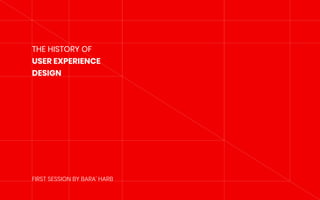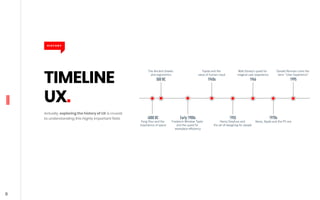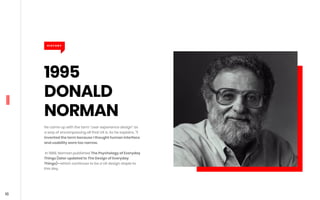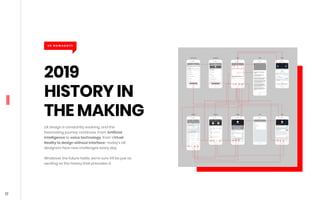The history of ux by bara' harb
- 1. THE HISTORY OF USER EXPERIENCE DESIGN FIRST SESSION BY BARA’ HARB
- 2. 2 INDEX. 01 03 0402 ASK YOURSELF UX DEFINITION UX NOWADAYS THE HISTORYNice to meet you l e t ’ s S t a r t
- 3. 3 ASK YOURSELF. Think about the last time you ate at a restaurant. What made you to choose that particular restaurant? What was your first impression as you walked in? Were you asked to wait until you were ushered to an available seat? How was the menu arranged? Did food come quickly enough? How did it taste? How was the customer service? Would you go back again? Q U E S T I O N S
- 4. 4 YOUR ANSWER. A N S W E R S Your answers to these questions, including all the emotional highs and lows, encompass the restaurant’s user experience (UX). However, when people use the term UX, they’re usually referring to one’s experience with a digital or technological product or service. The implication is that the user’s experience has been designed and is, at least potentially, further designable.
- 5. 5 USER EXPERIENCE. D E F I N I T I O N User experience refers to any interaction a user has with a product or a service Like an app or a website. Is the product easy to navigate? Is it easy to find the information you need? Is it easy to complete your desired tasks?
- 6. 6 DONALD NORMAN. S C I E N T I S T Donald Norman, a cognitive scientist, joined the team at Apple in the early 90s as their User Experience Architect—making him the first person to have UX in his job title. He is co-founder and principal of the User Experience/Usability consulting firm, the Nielsen Norman group, which is the home for his consulting and keynote talks.
- 7. 7 FIND THE ORIGINS. L E T ’ S F I N D Where does the concept of UX come from what factors and forces have shaped UX design as we know it today.
- 8. 8 TIMELINE UX. H I S T O R Y Actually, exploring the history of UX is crucial to understanding this highly important field.
- 9. 9 4000 BC FENG SHUI H i s t o r y Feng Shui is all about arranging your surroundings in the most optimal, harmonious or user-friendly way— be it an office, bedroom or entire building. It concerns everything from layout and framework to materials and colors. Just as an interior designer might arrange the furniture in a way that makes it easy for the inhabitant to navigate the room, a UX designer would apply similar principles to the task of creating a mobile app. H I S T O R Y
- 10. 10 500 BC THE ANCIENT GREEKS There is evidence to suggest that, as early as the 5th century BC, Greek civilizations designed their tools and workplaces based on ergonomic principles. According to the International Ergonomics Association, ergonomics—or human factors—is “the scientific discipline concerned with the understanding of interactions among humans and other elements of a system, and the profession that applies theory, principles, data and methods to design and optimize human well-being and overall system performance.” H I S T O R Y
- 11. 11 ERALY 1900 FREDERICK Taylor Fast forward a few thousand years to meet Frederick Winslow Taylor, a mechanical engineer and pioneer of Taylorism—otherwise known as Scientific Management. On a mission to make human labor more efficient, Taylor conducted extensive research into the interactions between workers and their tools. In 1911, he wrote “The Principles of Scientific Management” in which he asserted that systematic management is the solution to inefficiency. H I S T O R Y
- 12. 12 1940 TOYOTA “LEAN” Continuing on the quest for workplace efficiency, Toyota developed their famous human-centered production system. Unlike Taylorism, the Toyota Production System was based upon respect for people, and much attention was paid to creating the optimal working environment. Not only that: human input was considered crucial, and was actively encouraged. Toyota factory workers could pull a cord to stop the assembly line if they had feedback or suggestions to improve the process, for example —like usability testing in action, if you will. H I S T O R Y
- 13. 13 1955 HENRY DREYFUSS Henry Dreyfuss, an American industrial engineer who was renowned for designing and improving the usability of some of the most iconic consumer products—including the Hoover vacuum cleaner, the tabletop telephone and the Royal Typewriter Company’s Quiet DeLuxe model. Dreyfuss’ design philosophy was based on common sense and scientific approaches. In 1955, he wrote Designing for People, which pretty much explains UX design in a nutshel. H I S T O R Y
- 14. 14 1966 WALT DISNEY Walt Disney is often hailed as one of the first UX designers in history. Indeed, Disney was obsessed with creating magical, immersive, near-perfect user experiences, and the way he set about building Disney World was a true stroke of UX genius. In his article for UX Magazine, Joseph Dickerson outlines Walt Disney’s guiding principles for his team of engineers—or Imagineers, as he called them: know your audience, wear your guest’s shoes, communicate with color, shape, form and texture… H I S T O R Y
- 15. 15 1970s XEROX, APPLE THE PC ERA The 1970s kicked off the era of personal computers, with psychologists and engineers working together to focus on the user experience. Many of the most influential developments came out of Xerox’s PARC research center, such as the graphical user interface and the mouse. In many ways, PARC set the tone for personal computing as we know it today. And now over to Apple. In 1984, the original Macintosh was released—Apple’s first mass-market PC featuring a graphical user interface, built-in screen and mouse. H I S T O R Y
- 16. 16 1995 DONALD NORMAN He came up with the term “user experience design” as a way of encompassing all that UX is. As he explains, “I invented the term because I thought human interface and usability were too narrow. In 1988, Norman published The Psychology of Everyday Things (later updated to The Design of Everyday Things)—which continues to be a UX design staple to this day. H I S T O R Y
- 17. 17 2019 HISTORY IN THE MAKING U X N O W A D A Y S UX design is constantly evolving, and the fascinating journey continues. From Artificial Intelligence to voice technology, from Virtual Reality to design without interface—today’s UX designers face new challenges every day. Whatever the future holds, we’re sure it’ll be just as exciting as the history that precedes it.
- 18. 18 USER EXPERIENCE. User experience refers to any interaction a user has with a product or a service Like an app or a website. Is the product easy to navigate? Is it easy to find the information you need? Is it easy to complete your desired tasks? A G A I N
- 19. 19 THANK YOU. F I N A L L Y If you fancy having a hand in shaping or sharing the future of UX, you can read about what it takes to know more about it by following all the resources I sent it in the email, you can also ask me if you have any questions about UX.


















